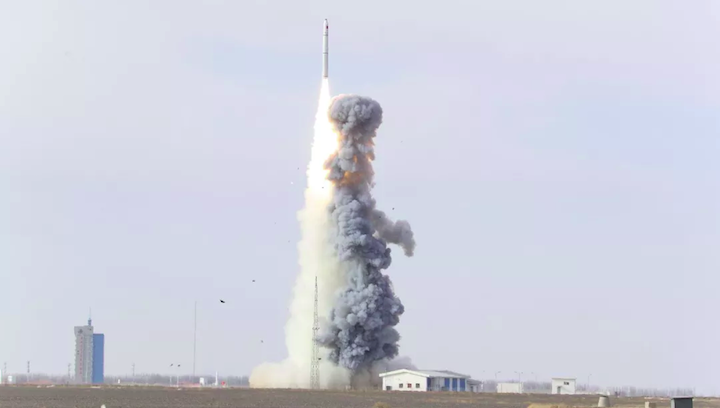China continued its quickfire start to a planned busy year of space launches with a Long March 11 solid-propellant rocket carrying a cluster of small satellites to orbit.
The country's fourth launch of 2018 took place at 12:10 local time (04:10 UTC) from the Jiuquan Satellite Launch Centre in the Gobi Desert.
The main passengers, sent to a Sun-synchronous orbit, were two Jilin-1commercial Earth observation video satellites (Lingqiao-07, 08) designed for high-resolution video imaging, with one taking the name Deqing-1 following sponsorship from Deqing county.
The satellites are developed by Chinese commercial satellite maker Chang Guang Satellite (CGST), an offshoot of Changchun Institute of Optics, Fine Mechanics and Physics (CIOMP), based in the northeastern province of Jilin.
China launches six small satellites on Long March 11
CGST is building a large constellation of satellites designed to offer high-resolution imaging, video, multispectral and wide swath coverage of the ground from low Earth orbit, providing remote-sensing data support to areas including land resources monitoring, mapping, smart city construction, environmental monitoring, disaster prevention and other areas.

A pair of Jilin-1 Earth observation satellites under development.
Xiaoxiang-2 was developed by TianYi Research Institute in Changsha, Hunan Province, also known as SPACETY, and carries four experiments, testing optical fibre sensing technology, space radio software, amateur radio and image stabilisation.
It also carries the name 'Hunan Xiangjiang New Area" for the area given special economic and development government support.

The SPACETY team with the Xiaoxiang-2 and Quantutong-1 CubeSats.
Also developed by SPACETY was Yizhuang Quantutong-1 (QTT-1), a technology verification for integrated navigation and communication payloads, along with micro remote sensing cameras and automatic identification system (AIS) receivers.
Both satellites are 6U CubeSats with a mass of around 8 kilograms.
Kepler Communications, a Canadian startup, had its first satellite launched on the Long March 11, according to the China Great Wall Industry Corp, which handles international contracts for launch services for CASC.

A rendering of the Kepler Communications CubeSat aboard the Long March 11 launch on January 19, 2018.
A 2 kg nano-satellite which involved primary and middle school students in the development and building process piggybacked on the launch. The Huai'an satellite was named after former premier Zhou Enlai.

The Huai'an CubeSat developed with student involvement.
Long March 11, Chinese launch plans
The Long March-11 is a small, four-stage solid-fuelled fast-response launch vehicle developed by the China Academy of Launch Vehicle Technology (CALT), which belongs to CASC, the main contractor for the Chinese space programme.
The rocket is 20.8 metres in height, with a diameter of 2.0 metres and a liftoff mass of 58,000 kg. The launch today was the rocket's third overall.
The Long March-11’s first launch took place on September 25, 2015, with the second, carrying an x-ray pulsar navigation satellite and Xiaoxiang-1 for SPACETY.
The rocket could be used for China's first sea launch this year.

Animation of a Long March 11 launch.
This was China and CASC's fourth launch of 2018 out of a planned 35. Together with expected commercial rocket launches from CASIC, OneSpace and others, China could carry out more than 40 launches this year. This would almost double the Chinese record for space launches in a year, which stands at 22 set in 2016.
Previous launches this year saw a pair of SuperView-1 commercial Earth observation satellites from Taiyuan, a duo of Beidou-3 GNSS satellites from Xichang, and a LKW-3 reconnaissance satellite from Jiuquan.
Overall this was the 264th launch of the Long March rocket families, with the first taking place on April 24, 1970. Of these, 250 have been successful, with eight failures and six partial failures, with an overall success rate of 94.7 percent.
100th launch from Jiuquan
The launch was also the 100th orbital launch attempt from the Jiuquan Satellite Launch Centre in Gansu province, according to Chinese military and space sector sources.
Jiuquan was established as China first launch site in 1958, with the first space launch, the Dongfanghong-1 satellite aboard a Long March 1, taking place on April 24, 1970.
It has since launched 11 Shenzhou spacecraft, including six crewed missions and two Tiangong spacelabs.

Shenzhou-11 lifts off atop a Long March 2F at Jiuquan on October 17, 2016.



